Official Name
Београд (Beograd). That's the original Serbian name, but internationally the town is known as Belgrade resp. Belgrad. [ bel ] derives from [ belo ], which is Slavic and means [ white ] (although the word had many more meanings in the Middle Ages). [ -grad ] is the Slavic word for [ white ]. The first Celtic, than Roman settlement in present-day Belgrade was known as Singidunum, the present name first appeared in the year 878. The Hungarian name is completely different: Nándorfehérvár.
Location
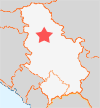
| ||
| Belgrade |
Belgrade lies in the heart of Serbia. From three sides it's surrounded by the Војводина (Vojvodina), which was once an autonomous province with a strong Hungarian minority. The town is located at the confluence of the river Сава (Sava) and the Дунав (Dunav, Danube). The old town including the fortress towers above the confluence on the top of a small plateau, which means that it was naturally protected on three sides. The central part occupies the stretch between the right bank of the Danube and the right bank of the Sava. The almost completely flat Vojvodina starts at the left bank of the Danube. Belgrade's large new town is located on the left bank of the river Sava.
Population
About 2 millions - this means, that almost every 4th Serb lives in the capital.
Orientation
As mentioned above, the old town, in Serbian Стари град (Stari Grad), as well as the large Калемегдан (Kalemegdan Citadel) occupy a wide but steep spur right above the place where the river Sava flows into the long river Danube. A perfect place for a town so to say.
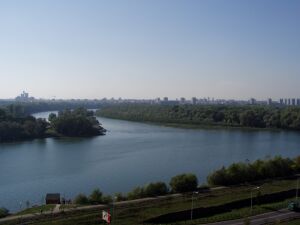 | ||
| The Danube (right), the Sava (left) and Novi-Beograd |
The главна железничка станица (Central Train Station) is located in the southern part of the city centre. It's surrounded by some modern boulevards and several administrative buildings. There are a couple of more or less big islands in both rivers. The largest, park-like islands are called Велико Ратно (Veliko Ratno) and Ада Циганлија (Ada Ciganlija). The huge new town is simply called Нови Београд (Novi Beograd, novi=new) and stretches far to the west on the other side of the river Sava. Hence, the old town and the new town are clearly separated. The middle of the old town is defined by Трг Републике (Trg Republike, trg=square). There you will also find the tourist information, hidden in an underground passageway (but easy to find). From Republic Square, two pedestrian zones running parallel to each other lead all the way to the fortress Kalemagdan. One is called Кнез Михаилова (Kneza Mihaila, Prince Michael), the other one Чика Љубина Chika Lyubina. Surprisingly, Belgrade doesn't look like a town in the Balkans at all - the atmosphere is rather similar to Middle or Northern European towns. Another interesting place is the vibrant Студентски Трг (Studentski Trg) with several university buildings, book vendors and a pleasant artist's district next to the square. All in all, Belgrade is a lovely place worth an extensive walk.
History
Since the location is really great, the first settlement was already founded during the 3rd century and named Singidunum. The Roman Empire occupied the town in the 1st century AD and remained there until the 5th century. During the 8th century, first Slav tribes arrived in the area and renamed the town Beograd. After the defeat of the Serbs by the Ottomans at Косово Поље (Kosovo Polje), see also →History of Serbia, the Serbs moved northwards and transferred the capital to Belgrade in 1403. But in the year 1521, the Ottomans reached Belgrade and destroyed the town completely. Serbia gained autonomy rights in 1842, and so Belgrade became the capital again. After 1918, it was the capital of the Kingdom of Serbs, Croats and Slovenes. It was also the capital of the 1st Yugoslav state as well as of the 2nd Yugoslavia after WW II. Ever since, Belgrade was the largest and most important town in Yugoslavia.
Historians estimate that Belgrade was not less than 40 times destroyed during its long history. The last one took place only a few years ago, and it's left its scars again. NATO air raids hit several targets not only outside the town but also in the centre (see picture below). Most buildings have been rebuilt, so by the time you read this you will probably hardly find any ruins or so. Thanks god.
Getting there / transportation
The international airport Сурчин (Surchin) is around 18 km away west of the centre of town. Since Belgrade is the largest town in Serbia, it's also the major transport hub and so it's easy to get there and away. The Glavna Zeleznicka Stanica (main train station) lies south of the centre and is within walking distance of all major sights. Adjacent to the train station there's the bus station. For more details on how to get to Belgrade and Serbia see →travel information Serbia. Most of the bridges to the northern part of Serbia have been rebuilt, so trains to →Novi Sad and other destinations operate again. The local train there costs 135 Dinar (€ 2), the trip takes two hours.
Almost everything (except for the new town, of course) is within walking distance. But the town also has an excellent tram and bus network.
The old town centre of Belgrade is a surprise: Although the town was destroyed 40 times or so, it still offers a great variety of historical buildings and an interesting, genuinly cosmopolitan flair.
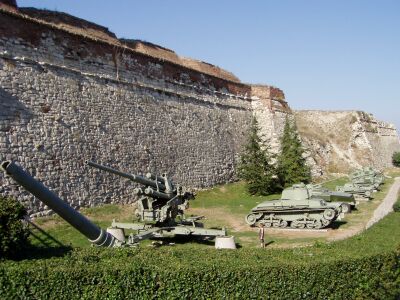
| ||
| Belgrade: The moat of Kalemegdan Citadel |
On the top of a spur next to the confluence of the river Sava and the Danube you will find the ruins of Belgrade's Kalemegdan Citadel, which is partially surrounded by a very nice park. The Celts were the first to try to fortify the strategically very important ledge. Romans, Slavs and Ottomans followed, and all of them have left their footprints. Walls, gates, Turkish baths, moats and so on - it's an interesting mixture of various elements. The moat is used as an open-air museum showing war matériel such as tanks, mortars, heavy guns etc used in the war for independence as well as during the two World Wars. The highest point of the fortress offers a fantastic view over parts of the town and the rivers (see picture above). There's also a large monument. The name 'Kalemegdan' derives from the Turk words [ kale ], which means [ fortress ], and [ megdan ], which means [ battle ], and explains the purpose of the fortress fairly well - to spot the enemy before he arrives in order to involve him in a battle.
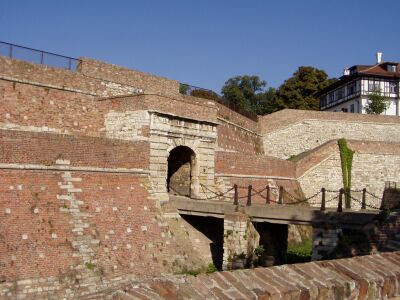
| ||
| Belgrade: One of the gates of Kalemegdan Citadel |
Today the citadel is used for various things. There are some basketball and other pitches in the outer moat as well as several museums. One of them is the Војни музеј Vojni Muzai (War Museum), depicting the long military history of Serbia - and there's a lot to tell! The museum is closed on Mondays. Next to the entrance to the museum there's a new but badly hit, armoured Humvee - definitely from the 1990ies.
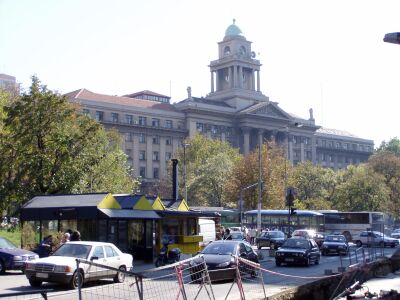
| ||
| Belgrade: The Serbian Parliament |
Many of the buildings of the Serbian administration as well as of the Serbo-Montenegrin Federation concentrate within a small area a few hundred metres east of the train station. Among them. there's the large building of the Government of the Republic of Serbia on Nemanjina between the train station and the Трг Славија (Slavic Square).
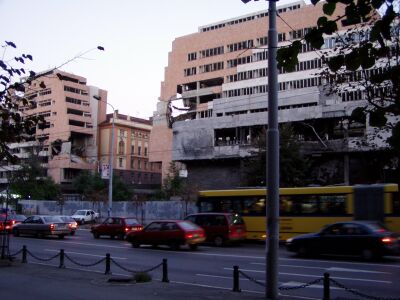
| ||
| Belgrade: Neighbouring buildings remained intact, but... |
In order to end the Kosovo conflict, ie to force the government into pulling out the JNA (Yugoslav National Army) from the →Kovoso, the UN ordered the NATO to attack relevant targets all over Serbia. Relevant targets were mainly defined as military areas, bridges and other infrastructure, large factories as well as administration buildings. It didn't matter at all where the target was located - buildings in the absolute centre of towns as well as chemical industry close to residential areas were attacked by combat aircrafts. The picture above shows a completely destroyed building not far from the central train station. As a matter of fact, the precision of the attacks is quite impressive - the building in the front received several direct hits, but the adjacent building was not damaged at all. Nevertheless, I have my doubts about this kind of warfare - was it really necessary to guide missiles to the centre of town?
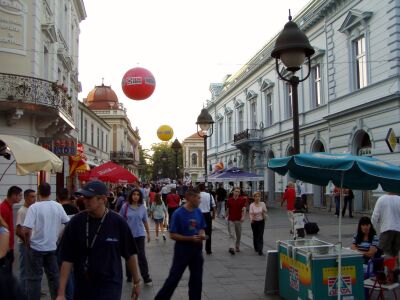
| ||
| Vibrant pedestrian zone Knez Mihailova |
Belgrade offers striking contrasts: Recently bombed buildings here, pedestrian zones with countless cafés and boutiques bustling with life there. This could be Hamburg or Stockholm as well.
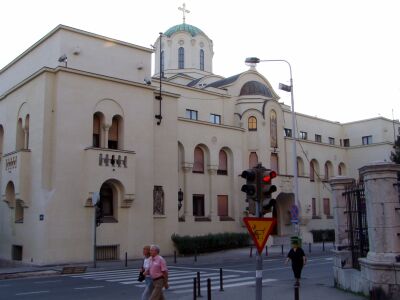
| ||
| Serbian-Orthodox Cathedral Sveti Marko |
Compared to other towns in Europe, the number of churches is surprisingly small. This is probably also due to the fact that the town was under Ottoman control until the late 19th century. Not to forget the countless raids the town has undergone. Among the churches in town. there's the Serbian-Orthodox Cathedral built in the 1930ies not far from Kalemegdan Park.
I'm not sure if there's plenty to see in the vicinity of Belgrade. The town is large and includes wide industrial and residential areas in the suburbs. However, →Novi Sad north of Belgrade is two hours away by train and definitely worth a visit, too.
Several inexpensive hotels concentrate in the area around the central train station. Among them, Хотел Центар (Hotel Zentar) faces the square Савски Трг (Savski Trg) in front of the train station. The hotel itself is not too bad and quite clean (apart from one or two tiny cockroaches, but who wants to be nitpicking...). A double costs 1,580 Dinar (euro; 24) incl. breakfast; bathroom and toilet are in the room. The restaurant inside the hotel is quite okay, too. The hotel is not easy to spot from outside - just look for the correct house number - here's the address: Savski Trg 7, Tel: 644 055, Fax: 657 838.
When you walk along the first street left of the hotel, you will see Хотел Асториjа (Hotel Astorija) on the left side. Inside this hotel at the reception there's an exchange booth. The hotel itself is substantially more expensive than Hotel Zentar.
- www.beograd.org.yu Official, useful and quite impressive website of Belgrade.
Do you have or do you know a good website about Belgrade? Don't hesitate, let me know! After checking it, I would love to add it to the link list. You can submit a link by using the →contact form. Note that commercial websites will be treated differently.
Vladimir Milosavljevic wrote:
1. Image titled "The Serbian Parliament": not even close, that's headquorter of national serbian railway.
2. Image titled "Neighbouring buildings remained intact, but...":
Neighbouring buildings were also heavily demaged, but renewed.
3. Image titled: "Serbian-Orthodox Cathedral Sveti Marko":
Nope, that's not even a church, this is Serbian ortodox church patriarhat, or serbian church's headquorters.
Posted by Vladimir Milosavljevic on April 3, 2008 18:33
©2024 Europe-East.com

 Albania
Albania Serbia
Serbia